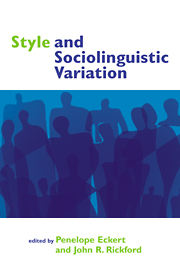Book contents
- Frontmatter
- Contents
- List of figures
- List of tables
- List of contributors
- Acknowledgments
- Introduction: John R. Rickford and Penelope Eckert
- Part I Anthropological approaches
- Part 2 Attention paid to speech
- Part 3 Audience design and self-identification
- 9 Back in style: reworking audience design
- 10 Primitives of a system for “style” and “register”
- 11 Language, situation, and the relational self: theorizing dialect-style in sociolinguistics
- 12 Couplandia and beyond
- 13 Style and stylizing from the perspective of a non-autonomous sociolinguistics
- Part 4 Functionally motivated situational variation
- References
- Index
12 - Couplandia and beyond
Published online by Cambridge University Press: 07 December 2009
- Frontmatter
- Contents
- List of figures
- List of tables
- List of contributors
- Acknowledgments
- Introduction: John R. Rickford and Penelope Eckert
- Part I Anthropological approaches
- Part 2 Attention paid to speech
- Part 3 Audience design and self-identification
- 9 Back in style: reworking audience design
- 10 Primitives of a system for “style” and “register”
- 11 Language, situation, and the relational self: theorizing dialect-style in sociolinguistics
- 12 Couplandia and beyond
- 13 Style and stylizing from the perspective of a non-autonomous sociolinguistics
- Part 4 Functionally motivated situational variation
- References
- Index
Summary
Coupland's chapter – the distillation of known years of academic angst – represents a bold forge into new territories. It is a provocative and welcome challenge, and particularly with its appeal to structuration theory and “personhood.” In what follows, and in the spirit of the inter-disciplinary ethos of this volume, I shall suggest ways in which the directions he proposes can be enriched by sociopsychological research and theory.
The multiplicities of styles and contexts
A prime concern of Coupland's is our overconcentration on uni–multidimensional approaches to style. He proposes that we need to focus upon more than one continuum of style, that is, beyond formality–informality. I agree that we need a more eclectic framework which encompasses a wider range of contextual definitions. Some years ago, we examined the work of social psychologists who claimed to have discovered a finite number of the ways in which individuals define situations in their minds' eyes (Giles and Hewstone 1982); in other words, how speaker–hearers carve up contexts psychologically and subjectively. Not surprisingly, perceived formality–informality was an important one of these; yet not the only one. At that time, we further suggested that an array of inter–individual variability in stylistic behaviors might be accounted for by moving away from objective definitions of contextual formality (e.g., where, and what, the context was, who was involved) to how speakers themselves defined the situations they were in. Indeed, what is a serious, formal topic for some, could be an utterly trivial irrelevance for others.
- Type
- Chapter
- Information
- Style and Sociolinguistic Variation , pp. 211 - 219Publisher: Cambridge University PressPrint publication year: 2002
- 3
- Cited by



